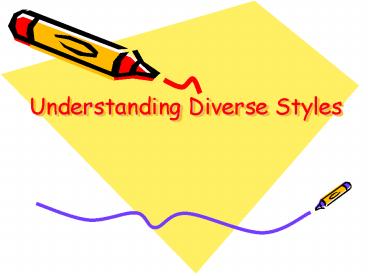Understanding Diverse Styles - PowerPoint PPT Presentation
1 / 12
Title:
Understanding Diverse Styles
Description:
Understanding Diverse Styles ... confidence or force Makes positive statements Is emphatic, quick, ... friendly Style Focus Less Responsive Reserved, ... – PowerPoint PPT presentation
Number of Views:88
Avg rating:3.0/5.0
Title: Understanding Diverse Styles
1
Understanding Diverse Styles
2
- Objectives
- To recognize and understand different social
styles and their characteristic behaviors - To increase your versatility for dealing
effectively with people of different styles - To identify changes you can make to work more
effectively with colleagues
3
In your groups discuss
- How we like to make decisions
- Communication Preferences
- What bothers us most at work is people who
- Our motto, theme could be
4
ASSERTIVENESS
- Low - (Asks)
- Asks questions more than make statements
- Uses quiet, submissive expressions
- Is deliberate, studied
- High (Tells)
- States opinion with assurance, confidence or
force - Makes positive statements
- Is emphatic, quick, dominant
5
Responsiveness
- Low - (Controlled)
- Appears preoccupied or watchful, on the alert
- Does not show feelings
- Is cautious, reserved, factual
- High (Open)
- Reacts readily to influence, appeals or
stimulation - Shows feelings, emotions and impressions
- Is eager, open, friendly
6
Style Focus
Analytical Facts Logic Structure Analysis Driver Tasks Action Efficiency Control
Amiable People Loyalty Team Family Expressive Vision Future Excitement
7
- Less Responsive
- Reserved, unresponsive
- Poker Face
- Infrequent eye contact
- Limited use of gestures
- Wants details, facts
- Limited expression of feelings
- Appears preoccupied or vigilant
- Less Assertive
- Monotone
- Deliberate, studied, slower
- Asks questions
- Leans back to make a point
- More Assertive
- Tone Changes
- Quick, clear, fast paced
- Make statements
- Leans forward to make a point
- More Responsive
- Animated
- Uses Facial gestures
- Frequent eye contact
- Hands free, palms up, open
- Enjoys social contact
- Shares feelings
- Smiles, nods
8
How they communicate
Analytical Ordered - specific Structured business like Ground rules - agendas How? Driver Abrupt to the point Brief Sense of urgency What?
Amiable Warm - friendly Humorous - abundant Personal mixed with business Why? Expressive Abstract - aloof Sometimes wordy Tangential, visionary Who?
9
Pros and Cons
Analytical Pros Cons Industrious Critical Persistant Indecisive Serious Stuffy Exacting Picky Orderly Moralistic Driver Pros Cons Strong willed Pushy Independent Severe Practical Tough Decisive Dominating Efficient Harsh
Amiable Pros Cons Supportive Conforming Respectful Unsure Willing Pliable Dependable Dependent Agreeable Awkward Expressive Pros Cons Ambitous Manipulative Stimulating Excitable Enthusiastic Undisciplined Dramatic Reacting Friendly Egotistical
10
How they Work
Analytical Gets job done with logical analysis problem solving Facts, data, reason Driver Gets job done with practicality and efficiency Action, control
Amiable Gets job done cooperatively with people Support, long-term relationships Expressive Gets job done with enthusiasm and excitement Hunches, opinions, inspiration
11
Problems They Present
Analytical Does not declare or decide Driver Does not ask or listen
Amiable Does not want to disrupt Expressive Does not check
12
Style Toxicity
Analytical Slow reaction Minimum concern for relationships Maximum effort to organize Historical time frame Cautious action Rejects involvement Driver Swift reaction Maximum effort to control Minimum concern for relationships Immediate time frame Direct action Rejects inaction
Amiable Unhurried reaction Minimum concern for change Maximum concern for relationships Current time frame Supportive action Rejects conflict Expressive Rapid reaction Maximum effort to involve Minimum concern for routine Future time frame Impulsive action Rejects isolation































